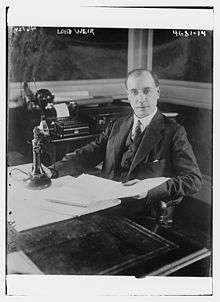William Weir, 1st Viscount Weir
| The Right Honourable The Viscount Weir GCB PC | |
|---|---|
 Weir in 1918 | |
| President of the Air Board | |
|
In office 26 April 1918 – 10 January 1919 | |
| Monarch | George V |
| Prime Minister | David Lloyd George |
| Preceded by | The Lord Rothermere |
| Succeeded by | J. E. B. Seely |
| Personal details | |
| Born |
William Douglas Weir 12 May 1877 Crosshill, Glasgow, Scotland |
| Died |
2 July 1959 (aged 82) Giffnock, Renfrewshire, Scotland |
| Nationality | Scottish |
| Occupation | Industrialist |
William Douglas Weir, 1st Viscount Weir GCB PC (12 May 1877 – 2 July 1959) was a Scottish industrialist and politician, who served as President of the Air Council in 1918.
Early life
Weir was born in Glasgow in 1877, the eldest child of James Weir (1842/3–1920) and his wife, Mary Richmond (1848–1931). He attended Allan Glen's School and the High School of Glasgow before entering an apprenticeship in the business established by his father and his uncle, G. and J. Weir, manufacturers of condensers, pumps, and evaporators. His brother was J S Weir[1][2]
He married Alice Blanche MacConnachie (1882–1959), the daughter of John MacConnachie on 2 June 1904.[3]
Industrialist
Weir rose to become a director of G. and J. Weir, before serving as managing director between 1902 and 1915, and as chairman from 1910 to 1953. During World War I, he converted his factories to produce explosive shells.
He went on to hold a number of other directorships, including Lloyds Bank (1928–38), Imperial Chemical Industries (1928–53), International Nickel (1928–59), and Shell Transport and Trading (1939). He was also chairman of the Anglo-Scottish Sugar Beet Corporation.
Public servant
David Lloyd George appointed him to the unpaid position of director of munitions in Scotland in July 1915, he joined the Air Board in December 1916 and was made a Knight Bachelor in February 1917. He joined the Air Council in November 1917 and became its President in April 1918, resigning in December that year after the end of the war. He was appointed to the Privy Council in April and was raised to the peerage as Baron Weir, of Eastwood in the County of Renfrew, in the summer.[4]
He didn't desire any further political power, and went on to serve on a number of government committees, including those on civil aviation, economies in the fighting services, and co-ordination between the navy, army, and air force. During 1924 and 1925, Weir chaired the committee on electricity supply to plan the rationalisation of the United Kingdom's electrical power industry. His conclusions led to the Electricity (Supply) Act 1926, and the creation of the National Grid and the Central Electricity Board. He was appointed to the Order of the Bath as a Knight Grand Cross in 1934.[5]
In 1935, he was a member defence policy and requirements committee and became advisor to Sir Philip Cunliffe-Lister, later Viscount Swinton upon his appointment as Secretary of State for Air. He was behind the creation of shadow aircraft factories and was an advisor on national defence, resigning his position after Swinton's dismissal. He was created Viscount Weir, of Eastwood in the County of Renfrew in 1938,[6] and in 1939 he was director-general of explosives at the Ministry of Supply.
He was a founder and later president of the Royal Scottish Automobile Club and was elected to The Other Club in 1932.
Styles of address and honours
Styles of address
- 1877-1917: Mr Wiliam Douglas Weir
- 1917-1918: Sir William Douglas Weir
- 1918: The Right Honourable Sir William Douglas Weir
- 1918-1934: The Right Honourable The Lord Weir PC
- 1934-1938: The Right Honourable The Lord Weir GCB PC
- 1938-1959: The Right Honourable The Viscount Weir GCB PC
Honours
In addition to his knighthoods, barony and viscountcy, Weir received an honorary doctorate from the University of Glasgow in 1919, the freedom of the City of London in 1957, the Order of the Crown of Italy, and he became a Commander of the Légion d'honneur.[7]
In 2011 he was one of seven inaugural inductees to the Scottish Engineering Hall of Fame.[8]
| Political offices | ||
|---|---|---|
| Preceded by The Lord Rothermere |
President of the Air Council 1918–1919 |
Succeeded by J. E. B. Seely |
| Peerage of the United Kingdom | ||
| New creation | Viscount Weir 1938–1959 |
Succeeded by James Kenneth Weir |
| New creation | Baron Weir 1918–1959 | |
Archives
The archives of William Douglas Weir are maintained by the Archives of the University of Glasgow.
See also
- (Air Commodore) James George Weir, a relation
References
- ↑ Later also active in the Air Ministry
- ↑ Flight July 22, 1920
- ↑ "Glasgow Herald". 3 July 1959.
- ↑ The London Gazette: no. 30787. p. 8063. 9 July 1918. Retrieved 2 August 2009.
- ↑ The Edinburgh Gazette: no. 15032. p. 10. 5 January 1934.
- ↑ The London Gazette: no. 34527. p. 4239. 1 July 1938. Retrieved 2 August 2009.
- ↑ "Weir, 1st Viscount". Who Was Who. Oxford University Press. December 2007. Retrieved 2 August 2009.
- ↑ "Scottish Engineering Hall of Fame". engineeringhalloffame.org. 2012. Retrieved 27 August 2012.
- Davenport-Hines, Richard (May 2009). "Weir, William Douglas, first Viscount Weir (1877–1959)". Oxford Dictionary of National Biography. Oxford University Press. doi:10.1093/ref:odnb/36818. Retrieved 2 August 2009. (subscription or UK public library membership required)